
views
X
Research source
Groin strains are frustrating because they can take 4-8 weeks or longer to fully heal, but properly wrapping the area with athletic bandages or a dedicated groin support wrap will aid in your recovery process by limiting movement of the injured muscles. There are several similar but slightly different wrapping techniques you can try until you find the best one for your injury.
Wrapping a Straight Leg with Elastic Adhesive Tape

Start the wrap at the mid inner thigh on the injured leg. Have the injured person stand with their legs straight and evenly spaced, facing you. Start the wrap by sticking the elastic adhesive medical tape to their inner thigh about halfway between their knee and crotch. Angle the tape slightly upward, as you’ll be wrapping in that direction. You can use an elastic non-adhesive sports wrap instead, if desired. You’ll just have to tape the wrap in place when you’re done. This wrap works best on bare skin, so remove or “hike up” as much clothing as modesty permits. Or, tape over compression shorts (and shirt) if necessary.
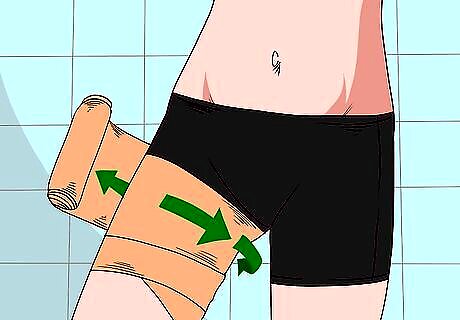
Wrap the tape around and up the leg as high as possible. Come up over the front of the leg, around the back of the leg, and overlap your starting point by about half the width of the tape. Continue wrapping around and up until you are as close to the inner top of the leg as is feasible. You want the tape to cause some compression of the muscles, but don’t pull it excessively tight. If the leg below the tape loses its normal color or tingles, the tape is too tight and must be removed and replaced more loosely.
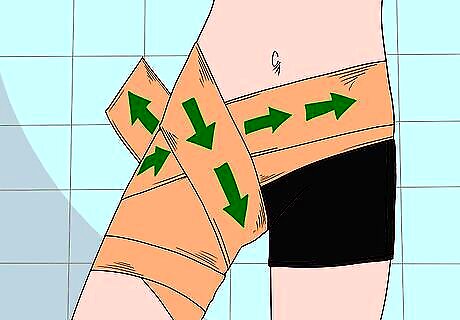
Bring the tape around and over both hips. Once you’ve reached the inner top of the leg, continue around the outer leg, up over the upper buttocks, and over the opposite hip (of the uninjured leg). Go right over the hip bone. Then, continue the tape over the lower abdomen and just below the hip bone on the injured side.
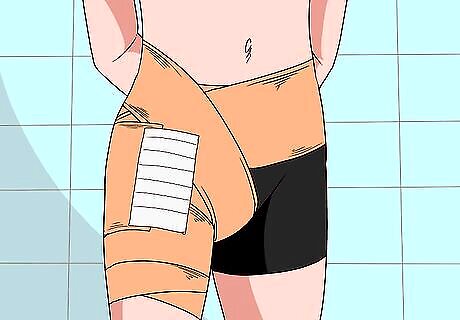
Finish the wrap by overlapping the tape on the upper leg. From the same-side hip, go down around the back of the leg and around the existing tape job. Wrap the tape around the leg (and existing tape) once or twice for secure adhesion. Then cut off the tape and you’re all set! If you’ve used a non-adhesive elastic bandage instead of tape, you’ll need to wrap around the loose end of the bandage with athletic tape to hold it in place. Go around the entire leg once or—even better—twice with the tape. This type of wrap will allow for generally free movement, but should not be seen as a license to return to full physical activity. Consult your doctor or physical therapist for your proper recovery timeline.
Wrapping a Slightly Bent Leg with an Elastic Bandage
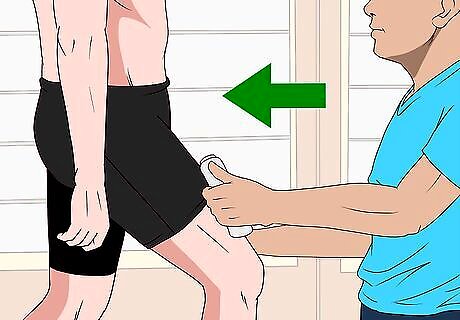
Position the injured person’s leg for wrapping. Have the person stand facing you with their hips square. Ask them to step forward slightly (about a half step) with their injured leg, turn their foot in slightly, and keep their knee bent enough that their heel lifts a few inches/centimeters off the ground. Their hips should remain square and facing you. For their comfort, place a rolled up towel or some other prop under their lifted heel while you wrap their leg. This leg maneuver tenses up the upper leg muscles and allows for a slightly tighter wrap with the non-adhesive elastic bandage.
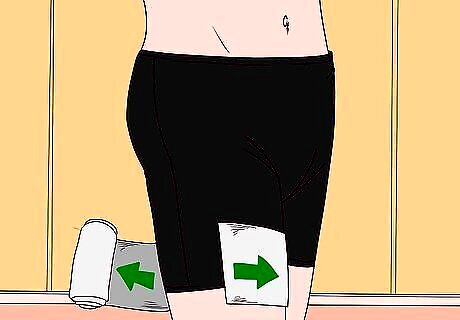
Start the wrap on the outer mid-thigh. Make sure that you use a large wrap. Place the wrap end on the outer leg, about one-third of the way up from the knee to the hip bone. Bring the wrap over the front of the leg and all the way around the leg, working slightly upward. Overlap the starting point by about half the width of the wrap. Pull the elastic bandage snug as you work. You want it to be tight, but if the person’s leg loses its normal color or begins to tingle, the wrap is too tight and must be immediately replaced. Non-adhesive elastic bandages work better over clothing than elastic adhesive tapes, but the clothing should be skin-tight (e.g., compression shorts and shirt). If you choose to do this wrap technique with adhesive tape, wrap it over bare skin as much as possible.
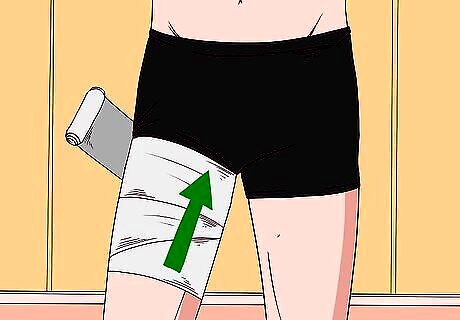
Wrap up to the top of the leg and over the hips. Once you’ve reached the inner top of the leg, come around the back of the leg with the bandage, then go up over the upper crotch/lower abdomen and onto the opposite hip bone (on the uninjured leg). Bring the bandage across the lower back/upper buttocks and over the hip bone on the injured side.
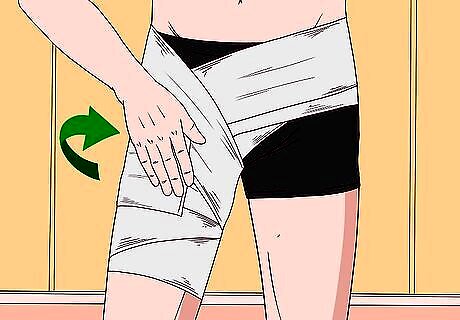
Finish the bandage wrap around the leg. From the injured-side hip, bring the tape down over the front to the top inner thigh. Overwrap the existing bandage once or twice, going completely around the leg. Either keep wrapping around the leg until you run out of bandage or—better yet—wrap up and over the hips once or twice more. When you’re finished wrapping, ask the injured person to hold the end of the bandage tight while you grab some elastic adhesive tape.
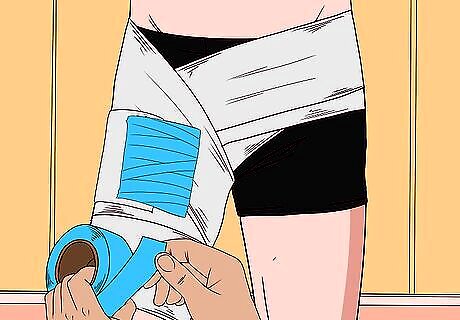
Tape over the elastic bandage to hold it in place. You can simply tape around the leg a couple of times to hold the non-adhesive elastic bandage in place. For the best hold, though, repeat the entire wrap with the tape—that is, go around the leg, up over the hips, and back down over the leg with the tape. Like any other groin wrapping technique, this one should reduce your pain and increase your mobility, but it isn’t a cure. You are still injured, and should follow your medical professional’s advice about returning to activities. Keep the bandage close to the skin, but not so tight that it cuts off circulation. It should be snug and there should not be any wrinkles in it.
Using a Dedicated Groin Wrap in Your Recovery Process
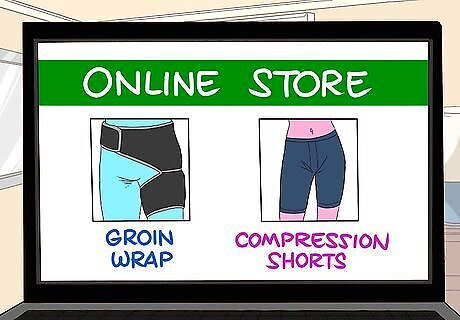
Buy a groin wrap or specialized compression shorts. You can find many types of groin wraps online or at sporting goods stores. They are typically made of an elastic material and have Velcro closures to hold them snug. They’ll typically wrap around your leg, up over your hips, and then finish back over the leg. You can also buy compression shorts that are specially-made to provide extra support to an injured groin. Both of these products are easier to apply yourself than are tape or elastic bandages, which are best applied by another person. A properly-done tape or bandage job may produce better results, however.
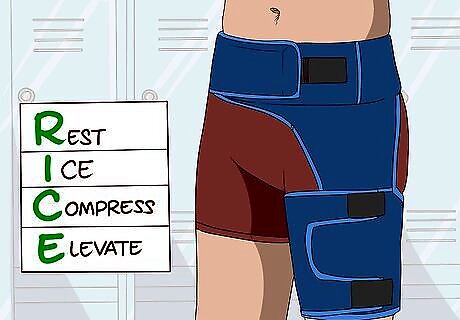
Use a groin wrap as part of the RICE method for healing. No matter how you wrap it, you have to give a groin injury time to heal. Experts often promote what is known as the RICE method—Rest, Ice, Compress, and Elevate. Wrapping the injury fulfills the “compress” component. Get your doctor’s input on how often to wrap your groin, how tightly to wrap it, and what types of activities you can do while it is wrapped. You don’t want to risk further injury.
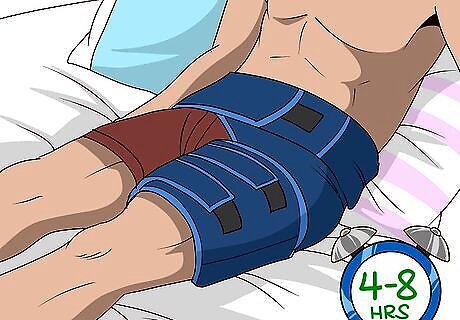
Rest your injury as much as possible. You simply cannot rush the healing process of a groin injury. For a mild or moderate groin strain, expect to need at least 4-8 weeks to recover. During this time, you should rest the injured muscle as much as possible. Work with your medical professional regarding your timetable for resuming different levels of activity during your recovery. Groin strains come in three grades. A grade 3 strain means the muscle is completely or nearly completely torn. The recovery time here will be greater than 8 weeks, and surgery may be necessary. Make sure that you stop your activity and begin resting the injured muscles as soon as possible.
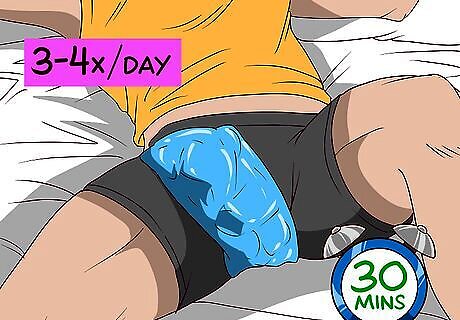
Ice your injured groin to reduce pain. Especially in the days right after your injury, your strained groin may cause you a fair amount of pain. Under your doctor’s guidance, apply a wrapped ice pack to the area 3-4 times per day as needed, for about 20-30 minutes at a time. Never apply ice or an ice pack directly to your body. The extreme cold can damage your skin.

Elevate your groin while lying down. When you go to bed or are resting flat on your back, stick a pillow or two under your pelvis to elevate your groin area. Keeping the area elevated when possible will help reduce pain, swelling, and inflammation, especially in the days after the injury.
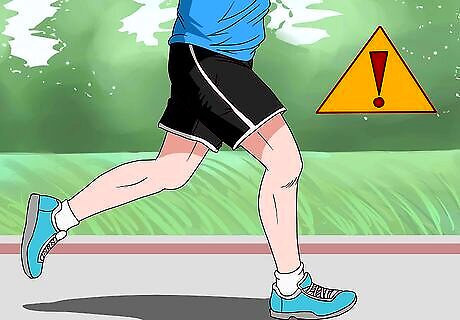
Use caution when engaging in activities that may reinjure the muscles. You can easily reinjure your groin again when you return to the same activities that injured it in the first place. Make sure to give yourself plenty of time to recover. Also, make sure to use proper form when engaging in the activity again. It is also important to wear the appropriate footwear for the activity to help prevent another injury. Don’t make any sudden movements or changes in direction as this will increase your chances of getting injured again.















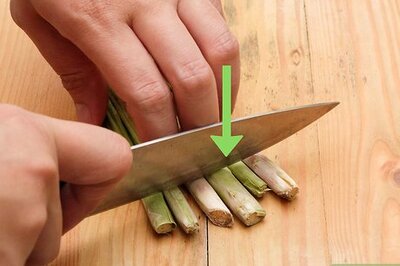




Comments
0 comment